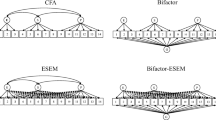Summary
The English original form of a standardized social interview was presented by Clare and Cairns (1978). The German version is described with regard to concept, structure, and methodology. The interview is designed to assess social maladjustment by measuring three conceptual categories (“Objective Material Conditions,” “Social Management,” and “Satisfaction”) in eight role areas. The instrument is especially suited for outcome assessment in various clinical and non-clinical populations and takes an average of about 30–45 min to complete. The 39 items are rated on 4-point scales either by the interviewer with the help of an extensive rating manual, or by the subject himself (all “Satisfaction” items). The results of a reliability study are presented using both the test-retest and the interrater method. In general, the results show that the instrument is satisfactorily reliable, but some possible weaknesses are discussed. Finally, the structure of the instrument is examined by an analysis of interrelationships between the items in a normal population sample. The results are discussed with regard to questions of score construction.
Similar content being viewed by others
References
Barrabee P, Barrabee EL, Finesinger JE (1955) A normative social adjustment scale. Am J Psychiatry 112:252–259
Bartko JJ (1966) The intraclass correlation coefficient as a measure of reliability. Psychol Rep 19: 3–11
Bartko JJ, Carpenter WT (1976) On the methods and theory of reliability. J Nerv Ment Dis 163: 307–317
Clare AW, Cairns VE (1978) Design, development and use of a standardized interview to assess social maladjustment and dysfunction in community studies. Psychol Med 8: 589–604
Cooper B, Eastwood MR, Sylph JA (1970) Psychiatric morbidity and social adjustment in a general practice population. In: Hare EH, Wing JK (eds) Psychiatric Epidemiology. Oxford University Press, London
Corney RH, Clare AW, Fry J (1982) The development of a self-report questionnaire to identify social problems — a pilot study. Psychol Med 12: 903–909
Donald CA, Ware JE, Brook RH, Davies-Avery A (1978) Conceptualization and measurement of health for adults in the Health Insurance Study, Vol. IV Social Health. Rand Corporation, Santa Monica
Everitt BS (1977) The analysis of contingency tables. London: Chapman and Hall
Faltermaier T (1983) Zusammenhänge zwischen sozialen Faktoren und psychiatrischer Morbidität. In: Kommer D, Röhrle B (Hrsg) Gemeindepsychologische Perspektiven 3 — Ökologie und Lebenslagen. Tübingen, Köln: DGVT/GWG
Faltermaier T (1982) Manual “Social Interview Schedule”: Deutsche revidierte Version (2. Fassung). Max-Planck-Institut für Psychiatrie, München (unpublished)
Frank JK (1961) Persuasion and healing. Baltimore: John Hopkins Press
Freeman HE, Simmons GG (1963) The mental patient comes home. John Wiley, New York
Goodman LA (1978) Analyzing Qualitative/Categorial Data. Abt Books, Cambridge (Mass)
Gurland BJ, Yorkston NJ, Goldberg K, Fleiss JL, Sloane RB, Cristol AH (1972) The structured and scaled interview to assess maladjustment (SSIAM). II. Factor analysis, reliability, and validity. Arch Gen Psychiatry 27: 264–267
Katz MM, Lyerly SB (1963) Methods for measuring adjustment and social behavior in the community. I. Rationale, description, discriminative validity and scale development. Psychol Rep 13: 503–535
Kedward HB, Sylph JA (1974) Social correlates of chronic neurotic disorder. Soc Psychiatry 9: 91–98
Kleining G (1975) Soziale Mobilität in der Bundesrepublik Deutschland. II: Statusoder Prestige-Mobilität. Kölner Zeitschrift für Soziologie und Sozialpsychologie 27: 273–292
Linn MW, Sculthorpe WB, Evje M, Slater PH (1969) A social dysfunction rating scale. J Psychiatr Res 6: 299–306
Mann AH, Jenkins R, Belsey E (1981) The twelve-month outcome of patients with neurotic illness in general practice. Psychol Med 11: 535–550
Moore H, Kleining G (1960) Das soziale Selbstbild der Gesellschaftsschichten in Deutschland. Kölner Zeitschrift für Soziologie und Sozialpsychologie 12: 86–119
Parsons T, Bales RF (1954) Family socialization and interaction process. Free Press, Glencoe, Illinois
Paykel ES, Weissman MM (1973) Social adjustment and depression: a longitudinal study. Arch Gen Psychiatry 28: 659–663
Paykel ES, Weissman MM, Prusoff BA (1978) Social maladjustment and severity of depression. Compr Psychiatry 19: 121–128
Paykel ES, Weissman MM, Prusoff BA, Tonks CM (1971) Dimensions of social adjustment in depressed women. J Ner Ment Dis 152: 158–172
Platt S (1980) On establishing the validity of ‘objective’ data: can we rely on cross-interviewer agreement? Psychol Med 10: 573–581
Platt S (1981) Social adjustment as a criterion of treatment success: just what are we measuring? Psychiatry 44: 95–112
Platt S, Weyman A, Hirsch S, Hewett S (1980) The Social Behavior Assessment Schedule (SBAS): rationale, contents, scoring and reliability of a new interview schedule. Soc Psychiatry 15: 43–55
Remington M, Tyrer P (1979) The Social Functioning Schedule — A brief semi-structured interview. Soc Psychiatry 14: 151–157
Serban G (1978) Social stress and functioning inventory for psychotic disorders (SSFIPD): measurement and prediction of schizophrenics community adjustment. Comprehensive Psychiatry 19: 337–346
Tanner J, Weissman MM, Prusoff BA (1975) Social adjustment and clinical relapse in depressed outpatients. Compr Psychiatr 16: 547–556
Weissman MM (1975) The assessment of social adjustment: a review of techniques. Arch Gen Psychiatry 32: 357–365
Weissman MM, Klerman GL, Paykel ES, Prusoff BA, Hanson B (1974) Treatment effects on the social adjustment of depressed patients. Arch Gen Psychiatry 30: 771–778
Weissman MM, Sholomskas D, John K (1981) The assessment of social adjustment: an update. Arch Gen Psychiatry 38: 1250–1258
Williams P, Tamopolsky A, Hand D (1980) Case definition and case identification in psychiatric epidemiology: review and assessment. Psychol Med 10: 101–114
Wing JK, Bebbington P, Robins LN (Eds.) (1981) What is a case? The problem of definition in psychiatric community surveys. Grant McIntyre, London
Wittchen H-U, v. Zerssen D (1985) Verlauf und Ausgang behandelter und unbehandelter psychischer Störungen. Springer, Heidelberg (In prep)
Wittchen H-U, Ellmann R, v. Zerssen D, Möller H-J (1983) Der Verlauf behandelter und unbehandelter psychischer Störungen. In: Kommer D, Röhrle B (Hrsg) Gemeindepsychologische Perspektiven 3 — Ökologie und Lebenslagen. Tübingen, Köln, DGVT/GWG
Author information
Authors and Affiliations
Rights and permissions
About this article
Cite this article
Faltermaier, T., Wittchen, HU., Ellmann, R. et al. The social interview schedule (SIS) — content, structure and reliability. Soc Psychiatry 20, 115–124 (1985). https://doi.org/10.1007/BF00583577
Accepted:
Issue Date:
DOI: https://doi.org/10.1007/BF00583577




